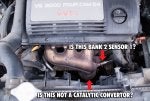Hi,
While driving the other day, my check engine light came on. After checking Tundrasolutions, I drove to my local Autozone, and bought a code reader for $65. (I live in Calif, so they would not check it for free) After I attached the code reader, I got a p0031 code. Again, looking it up on Tundrasolutions, I knew it was the bank 1 sensor 1 oxygen sensor. I took another drive to the dealer, where I had to shell out $167.00 for a new one. Now came the fun part. Replacing the old one!! The first step was to locate it. If followed the driver side exhaust, until i found the catalytic convertor. I looked in front of it, and there it was. Unhooking the plastic connector, was a challenge.
Using a super small screw driver, I lifted the tab on the bottom with one hand, and pried the connector apart with the other. Took a little while, but I was able to get it.
The next step was to get the sensor off.
![Image]()
I put some oil on the top part of the sensor, and then let it drip down. I then used the slotted socket, I bought for $15.00.
![Image]()
I slipped the wire through the slot, and with a little elbow grease, was able to take the sensor out.
![Image]()
I then screwed in the new one, and tightened it with the socket. Last step was to use the code reader to erase the code from the Tundra. After that, I fired up the car, and took it for a test drive. No more check engine light. Took about 1 hour to do, and was not tough at all. By the time I got done, it cost me $237 but that included the code reader, and socket. If you can get a free code check, that knocks $65.00 off it. I am still not sure how much the dealer would have charged me, but I have a feeling it would be more that $237
While driving the other day, my check engine light came on. After checking Tundrasolutions, I drove to my local Autozone, and bought a code reader for $65. (I live in Calif, so they would not check it for free) After I attached the code reader, I got a p0031 code. Again, looking it up on Tundrasolutions, I knew it was the bank 1 sensor 1 oxygen sensor. I took another drive to the dealer, where I had to shell out $167.00 for a new one. Now came the fun part. Replacing the old one!! The first step was to locate it. If followed the driver side exhaust, until i found the catalytic convertor. I looked in front of it, and there it was. Unhooking the plastic connector, was a challenge.
Using a super small screw driver, I lifted the tab on the bottom with one hand, and pried the connector apart with the other. Took a little while, but I was able to get it.
The next step was to get the sensor off.

I put some oil on the top part of the sensor, and then let it drip down. I then used the slotted socket, I bought for $15.00.

I slipped the wire through the slot, and with a little elbow grease, was able to take the sensor out.

I then screwed in the new one, and tightened it with the socket. Last step was to use the code reader to erase the code from the Tundra. After that, I fired up the car, and took it for a test drive. No more check engine light. Took about 1 hour to do, and was not tough at all. By the time I got done, it cost me $237 but that included the code reader, and socket. If you can get a free code check, that knocks $65.00 off it. I am still not sure how much the dealer would have charged me, but I have a feeling it would be more that $237







